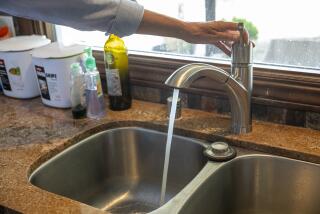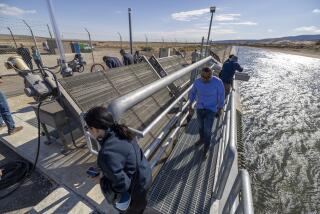San Diego’s water desalination efforts could get boost in federal funding

Desalination projects in the San Diego area could get millions in federal funding under a bill Rep. Mike Levin introduced Tuesday.
The Desalination Development Act would provide $260 million over five years for desalination projects across the country, including Oceanside’s Mission Basin Groundwater Purification Facility, which converts brackish flows into potable water, said Levin (D-San Juan Capistrano).
It also sets environmental standards for projects that get federal funding, with requirements for energy efficiency, wildlife protection and water conservation.
Levin said the federal government should invest in desalination to enhance local water sources, especially while California’s communities confront climate-driven droughts.
“Climate change is increasing the frequency and intensity of extreme drought,” Levin said. “This is a big challenge for our water supply. We’ve got to advance anything we can to increase our supply of drinking water, and we’ve got to do it in a sustainable way.”
Levin said he hopes the bill will be included in the bipartisan infrastructure packages under consideration in Congress. The House of Representatives passed a $715-billion package of transportation and water funding last month, and the Senate is debating a roughly $1-trillion bipartisan infrastructure package.
If the desalination funding doesn’t go through that legislation, Levin said it could be included in a broader $3.5-trillion spending plan that Democrats expect to introduce through the budget reconciliation process.
The desalination bill would pay 25% of costs for desalination systems, up to $20 million per project, and it would give precedence to facilities in areas facing severe drought conditions.
It also sets criteria for funding to make sure projects comply with state environmental laws and are compatible with local ecosystems.
To qualify for federal funding, desalination projects must reduce reliance on imported water, use renewable energy as much as possible to power the desalination process and maximize energy efficiency.
Funding recipients also have to show they have water conservation strategies in place and are taking steps to capture and recycle storm water and wastewater in their regions.
The systems also must be designed to reduce effects on marine life and avoid harming coastal wildlife.
A common way desalination produces freshwater is by forcing saltwater through reverse osmosis filters that remove salts, other minerals and bacteria. The method has been used as a supplemental water resource in the San Diego area for decades.
Since 1992 Oceanside wells have pumped brackish water from the Mission Basin area, near the municipal airport and San Luis Rey River, through reverse osmosis filters, to generate potable water.
In 2019, Oceanside added two new wells and a “brine optimization” system that extracts a higher percentage of freshwater from each well. With those additions, the desalination system provides about 15% of the city’s water supply.
The Sweetwater Authority also has produced drinking water from brackish groundwater at the Reynolds Desalination Facility since 1999. It underwent a $42-million expansion in 2017 through a partnership with the city of San Diego and now produces 10 million gallons a day — enough to supply 18,000 families, according to the authority.
Desalination moved further into the spotlight in 2015, when the privately run Poseidon Water opened its plant in Carlsbad, producing 50 million gallons a day — enough to supply 7% to 10% of the regional water supply.
Another potential project is in the pipeline at Olivenhain Municipal Water District, which supplies customers in Encinitas, Carlsbad, San Diego, San Marcos, Solana Beach and neighboring communities. In 2019, the district began tests to see if it could successfully operate a desalination system and estimated the facility would cost $30 million if it moves forward.
“For a drought-prone coastal community like ours, desalination is very viable and can be done in an environmentally responsible manner because we have an urgent and fundamental need for clean drinking water,” Levin said.
Levin is introducing the bill with Rep. Jared Huffman (D-San Rafael), chair of the House Natural Resources Subcommittee on Water, Oceans and Wildlife.
More to Read
Start your day right
Sign up for Essential California for news, features and recommendations from the L.A. Times and beyond in your inbox six days a week.
You may occasionally receive promotional content from the Los Angeles Times.







